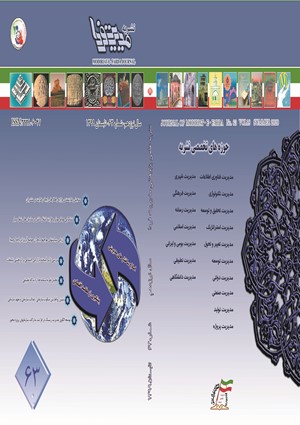توسعه مدلی جهت ارزیابی عوامل پذیرش فنآوری اطلاعات در بخش سلامت (مطالعه موردی: استقرار سیستم برنامهریزی منابع بیمارستانی در بیمارستانهای دولتی استان سمنان)
محورهای موضوعی : مدیریت فناوری اطلاعات
سید محمد حسن حسینی
1
![]() ,
ابراهیم خالقیان
2
,
محمد میرباقری جم
3
,
ابراهیم خالقیان
2
,
محمد میرباقری جم
3
1 - دانشکده مهندسی صنایع و مدیریت
2 - دانشگاه صنعتی شاهرود
3 - دانشگاه صنعتی شاهرود
کلید واژه: فنآوری اطلاعات مدل پذیرش فنآوری سیستمهای برنامهریزی منابع بیمارستانی بخش سلامت,
چکیده مقاله :
امروزه حرکت بهسوی فنآوریهای نوین برای سازمانها امری انکارناپذیر است. اما سازمانها میبایست پیش از انتقال فنآوری، همه جوانب ورود فنآوری به سازمان خود را مورد بررسی قرار دهند. پژوهش حاضر به بررسی عوامل پذیرش فنآوری اطلاعات در بخش سلامت پرداخته و در این میان استقرار سیستمهای برنامهریزی منابع بیمارستانی (HRP) در بیمارستانهای دولتی استان سمنان به عنوان مطالعه موردی بررسی میشود. لذا جامعه آماری پژوهش حاضر، کارکنان بیمارستانهای دولتی استان سمنان بوده که طی یک سال گذشته از سیستم اطلاعات منابع بیمارستانی استفاده کردهاند. تعداد کل افراد جامعه آماری مورد مطالعه حدود 600 نفر میباشد. با استفاده از فرمول کوکران و با لحاظ خطای 7% اندازه نمونه 147 برای انجام تحقیق حاضر بدست آمد. لذا تعداد 200 پرسشنامه بین افراد حائز شرایط توزیع و در نهایت تعداد 150 پرسشنامه کامل و سالم دریافت شد. توصیف دادهها از طریق نرمافزار SPSS و برای آزمون معادلات ساختاری از نرمافزار Smart PLS 3 استفاده شد. نتایج پژوهش حاضر، یک مدل بومی شده پذیرش فنآوری را در حوزه سلامت ارائه میکند. ضمن آنکه تحلیل عاملی در فاصله اطمینان 95% نشان داد که روانسازی فرآیندهای بیمارستانی بر سودمندی درک شده و تمایل به استفاده از فنآوری اطلاعات و سیستمهای برنامهریزی منابع بیمارستانی موثر است. همچنین تسهیلکنندههای سازمانی میتوانند موجب افزایش سهولت استفاده درک شده از این سیستمها میشوند. در نهایت امنیت این سیستمها نیز منجر به افزایش تمایل کارکنان به استفاده از آن خواهد شد.
Nowadays, it is an essential for organisations to move forward to achieve new technologies. However, organisations should assesment all aspect of technology transfere before do it for their own organisation. In this research, the factors affecting the acceptance of the Information Technology (IT) in health section is studied. For this, establishment the Hospital Resource Planning (HRP) in governmental hospitals of the Semnan is considered as case study and to investigate the relationship between effective factors, a survey research has been used. The research population consists of 600 qualified personnel of govermental hospitals in semnam state. Sample size was obtained 147 based on kochran method. Therefore, 200 number of questionnaires include 7 dimensons based on Vakentash model were distributed via simple random sampling. 150 perfect questionnaire were gathered and data were analysed using SPSS and smart PLS 3. Results in 95% confidence interval show that lubrication of hospital proccesses is affect on both of perceived usefulness and using tendency of Hospital Resource Planning (HRP) systems. In addition, organizational facilitators can cause in increasing perceived easly using of this system. Finally, the security of hospital resource planning systems will increase the willingness of employees to use it. The results of this study provide a native model of technology acceptance in the field of health care. According to these results, issues that authorities in hospitals and upstream organizations, including the Ministry of Health, should be ensure about them have been detected.
1. Venkatesh V, Davis FD. A theoretical extension of the technology acceptance model: four longitudinal field studies. Management Science, 46 (2): 186-204, 2000.
2. Venkatesh V, Morris MG, Davis FD, Davis G. User acceptance of information technology: Toward a unified view. MIS Quarterly, 27 (2): 45-78, 2003.
3. Sadeghi R, Yaghmayi F. Informatics applying in nursing; education: research and care. Iran Q Educ Strategies, 5 (3): 199-206, 2012. (Persian)
4. Gemmel P, Van Dierdonck R. Admission scheduling in acute care hospitals: does the practice fit with the theory. International Journal of Operations & Production Management, 19 (9): 863-878 1999.
5. Nursing and Midwifery. Tehran Univ Med Sci, 17 (4): 46-62 2011. (Persian)
6. Hajavi A, Zohor A. Analysis of patient information cycle in hospital information systems of oromie university of medical sciences. Proceedings of the 4th conference of electronic health; 2004. (Persian)
7. Chang, P. V. C., The validity of an extended technology acceptance model¬ (TAM) for¬ predicting intranet/portal usage, 2004.
8. Ahmadi H, Nilashi I. rganizational decision to adopt hospital information system: An empirical investigation in the case of Malaysian public hospitals. International Journal of Medical Informatics, 2014. (Persian)
9. Ghazi¬¬Saeedi M, Davarpanah A, Safdari R. Health information management. 1th ed. Tehran: Mahan press, 2007. (Persian)
10. Foster R. Human factors in health information systems: The Western Cape Experience. Department of the Premier: Provincial Government of the Western Cape, 2005.
11. Karami M, Shokrizadearani L. Impact of information technology in improving the health system from the perspective of hospital staff Shahid Beheshti. Health Info Manag, 8(6):835-841 2011. (Persian)
12. Sebetci,O zel. Enhancing End-User Satisfaction Through Technology Compatibility: An Assessment On Health Information System. Health Policy and Technology, 2018.
13. Sarmad Z, Bazargan A, Hejazi A. Research methods in mehavioral sciences, Tehran, Agah publication, 2013.
14. Noorliza K, Mohamed S. Antecedents for the Success of the Adoption of Organizational ERP among Higher Education Institutions and Competitive Advantage in Egypt. Engineering, Technology & Applied Science Research 1719-1724, 2017.


